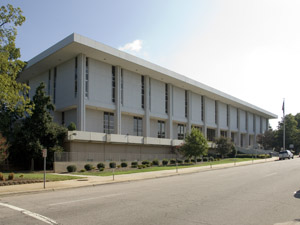Archives and collections
The Oklahoma State Archives housed at ODL preserves the permanent records of the executive, legislative, and judicial branches of Oklahoma’s state government. The archives houses manuscripts, photographs, maps, and some artifacts, and the collections primarily include minutes, correspondence, annual reports, and publications. Records range from the 1890s until present, with the bulk being between 1907 and 1980. Prominent collections include the Office of the Governor, Office of the Attorney General, Oklahoma State Legislature, Oklahoma Supreme Court, Oklahoma Department of Education, and Oklahoma Corporation Commission.
Selected records from the holdings of the State Archives are available on the agency’s electronic library, Digital Prairie. The collections, largely composed of digitized materials, highlight the work of Oklahoma’s state government and Oklahoma history and culture.
Archives.OK.Gov includes more than 2,200 publications and documents from the State Archives. The collection primarily includes state agency reports and newsletters, and the records range from 1907, when Oklahoma became a state, until 1978. Archives.OK.Gov complements Documents.OK.Gov, which provides access to over 27,000 state government publications dating back to 1978. Notable records in Archives.OK.Gov include the Department of Education’s annual Educational Directories, the Department of Charities and Corrections’ annual reports, and the Department of Wildlife Conservation’s Outdoor Oklahoma magazine. ]
Images of Oklahoma is a state digital collection project funded by IMLS (Institute of Museum and Library Services) to make unique social, cultural, ethnic, and historical content from local collections accessible across the state. The collection features over 2,100 items from 50 different institutions, including Oklahoma libraries, archives, and museums. The collection includes yearbooks, photographs, postcards, and other records reflecting Oklahoma’s history and culture. Some collections include the Eugene Meacham Photography Collection from Kingfisher, the Stillwater Woman’s Club Collection, and the Oklahoma Railway Museum Collection.
The Tulsa Race Massacre collection features documents and images from various Oklahoma state government agencies, such as the Governor’s office and the Attorney General’s office, regarding the investigation into the Tulsa Race Massacre of 1921. The collection includes eye-witness testimony, letters, telegrams, police reports, and court cases.
Territorial Records encompasses any records produced prior to Oklahoma’s statehood on November 16, 1907. The majority of these records are reports created by Oklahoma Territory agencies, such as the Territorial Attorney General, Territorial Board of Health, and Territorial Superintendent of Public Instruction.
The Oklahoma Governors collection contain the official papers relating to the principal and appointive powers and responsibilities of the Governor of Oklahoma.
Confederate Pension Records and Index Cards are collections of the finding aid (index cards) and complete files of more than 7,000 individuals who applied to the State Board of Pension Commissioners under the Confederate Soldiers’ Pension Bill. The index cards are organized by name and often include the address, name of the spouse, date of marriage, date of death, and information about the veteran’s military service. The files include applications and correspondence, which provide information about the applicants’ locations and situations. These records are often used for genealogical research.
Ada Lois Sipuel Legal Case Files collection features 251 imaged documents from the Oklahoma State Supreme Court, Civil Case No. 32756 regarding the first African-American woman admitted to the University of Oklahoma law school in 1948.
The Oklahoma Postcards collection features postcards from the George H. Shirk and Wayne Mackey postcard collections housed in the Oklahoma Collection. The postcards were donated by the Oklahoma Heritage Association. The collection also includes some postcards donated from other institutions and individuals.














